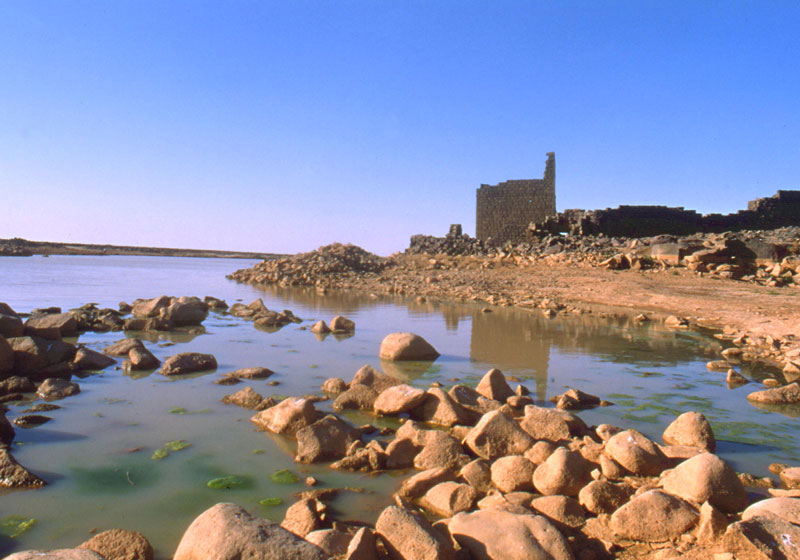The Castle by the Lake
Drive to Azraq, continue on the road to Iraq, about 50 kilometer from Azraq you will pass Safawi, drive on another 100 km and just before you reach Ruwayshid turn left, exiting the highway to Baghdad and drive north for about 18 km in the desert.
The landscape around should appear like a mudflat or wide riverbed. The area to the west of this network of dirt roads is slightly elevated as a plateau of black basalt stone.
The vicinity of Ghadeer Burqu’ has, usually, some Bedouin encampments and some sheep and camel herds. If you don’t see the silhouette of the castle after 15 to 17 km you should ask the first people you come across, if any, make sure you do not keep driving north, since if you cross another 40 km you will be approaching the borders with Syria.

The castle is situated at the mouth of a wide shallow valley, which makes it difficult to spot from a distance. As you get close, the distinguished feature of the structure (part of the upper wall that still stands almost to its original height) appears like a wide chimney. The best approach to the structure is from the southeast. You can then drive around and park just north of the castle.
The most stunning feature of Burqu’ is its relation with the lake. It is an overwhelming feeling to find this amazing water surface in the middle of the dry desert. In a good rainy season the water can touch the walls of the castle, where mud has left horizontal marks as records of good winters in the recent past.
The water, understandably, can explain the reason behind this location of this structure. A good section of an old dam is still visible to the north of the castle, and a contemporary earth dam further to the north holds the water just like the ancient dam did in the past.
The structure itself is a rectangular box surrounded by partially collapsed rooms outlining a courtyard. Burqu’ is basically Roman and can be seen as of the same historical background as Azraq castle. Its importance as one of the last "Roman" structures in the eastern desert marks the end of one region and the beginning of another. Just to the southeast of the high central structure and among the stones of the collapsed courtyard walls is a stone with impressive inscription in Arabic.
Burqu’ was occupied during the Byzantine period (possibly by monks) and during the Islamic period an inscription with the date 1409 might suggest an occupation till around that date.
To understand the bigger picture one has to think of caravan routes, trade, and the securing of water along these long and hard journeys in the past. It was at this location that travelers used to stop for water and rest, as did birds and many desert animals, such as gazelles, oryx, ostriches and other species one in abundance in the eastern desert but now extinct.
In some seasons, April in particular, the Qasr surrounding becomes a picnic grounds for bedouins arriving in their pickups to stay overnight, bringing this isolated spot of Jordan evenings of desert parties.
If you prefer the desert in silence, you will need to drive an additional 4 to 5 km to the west, in the basalt landscape, for a peaceful overnight camping location.
The Ghadeer Burqu’ destination might be combined with many other desert attractions in locations such as Um-el-Jamal, Qasr Sikhism, Dair al Kahf, and Dair Al-Qinn; all in the black basalt Jordanian desert.
A 4x4 reliable car is needed. A lot of drinking water. Compass and a good map of the eastern desert are recommended. From Amman, it would take around 3 hours to get there, and this destination might be tough for families with young children. Special care should be taken on the Zarqa-Iraq highway, it is extremely dangerous, and often slippery with petrol spilled from trucks coming from Iraq.